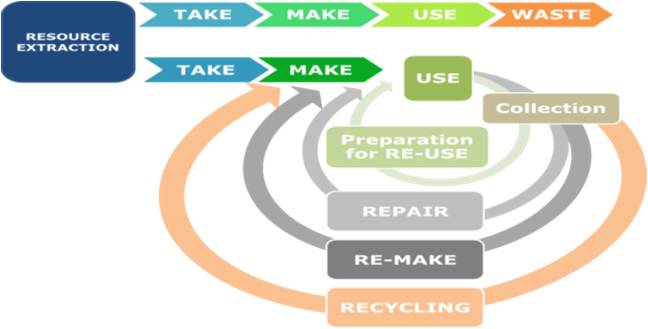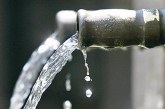By #DrArvindKumarPresidentIndiaWaterFoundation
“The world can maximize chances of avoiding dangerous #climatechange by moving to a #circulareconomy, thereby allowing societies to meet the goals of the #ParisAgreementonClimateAction. The #globaleconomy is only 9% circular – just 9% of the 92.8 billion tones of #minerals, #fossilfuels, #metals and #biomass that enter the economy are re-used annually, a key finding of The #CircularityGapReport2019, released by the organization #CircleEconomy”
#UnderstandingCircularEconomy
 “A #circulareconomy is a #socioeconomicsystem aimed at wise utilisation of resources. In a circular system, #resourceinput and #waste, #emission and #energyleakage are minimised through appropriate design, maintenance, #repair, #reuse, #remanufacturing, #refurbishing and #recycling.” The idea of #circulareconomy is aptly in line with #SustainableDevelopmentGoal12 which talks about ‘#ResponsibleProductionandConsumption’. Being Responsible is the need of the hour and to realise efficient #WaterManagementsystem, #CircularWaterEconomy should be the incorporated norm.
“A #circulareconomy is a #socioeconomicsystem aimed at wise utilisation of resources. In a circular system, #resourceinput and #waste, #emission and #energyleakage are minimised through appropriate design, maintenance, #repair, #reuse, #remanufacturing, #refurbishing and #recycling.” The idea of #circulareconomy is aptly in line with #SustainableDevelopmentGoal12 which talks about ‘#ResponsibleProductionandConsumption’. Being Responsible is the need of the hour and to realise efficient #WaterManagementsystem, #CircularWaterEconomy should be the incorporated norm.
#WaterisakeySocioEconomicfactor which integrates #SDGsAgenda2030 and #ParisPeaceAgreement in parallel. To augment the prospects of Circular Economy, we must renew the role of #Water as an Engaged & Effective Catalyst. This can be done by way of harnessing water as scarce resource and leveraging water as a natural capital to as to decipher the true value of the asset i.e. water. Climate-sensitive strategies focusing on waste-to-resource conversion, Clean & Efficient energy, transformation of Grey-to-Green Infrastructure, #Raingardens or #Rainwaterharvesting essentially revolve around circular economy.
Contrasting Circular with linear model, it can be said that “#LinearmodelofWatereconomy” has predominantly revolved around ‘#TakeMakeConsumeDispose’ model. Relating it to the arena of #watereconomy, it can be thought to consider water as a #naturalresource is continuously being Depleted rather than attempting to #Replenish, #Recharge, #Restock and #Recover (4R). Even our conventional wisdom allows us to consider water as a ‘#UsableNaturalResource’ and not a ‘Treasure’ is a matter of concern which must be disposed off at the earliest. In a linear model, water is sourced from #streams, #rivers, #lakes, #reservoirs, #oceans, and #aquifers as well as harvested rainwater. Water is then used for consumption in fields of #agriculture and #industry. The consumed water is then returned to the basin directly or via municipal treatment facility to be used for consumptive use. This clearly indicates a model of parochial and short sighted vision without any long term idea of sustainability or resource conservation.
Moving away from linear model, it was later realized that waste production must undergo 3Rs i.e. ‘#Reduce, #Reuse and #Recycle’ along a waste hierarchy. This was an improvement over linear model but did not enclose anything concrete & comprehensive. In contrast, #Circularwatereconomy envisages an efficient and efficacy based water cycle. This model brings forth an opportunity towards 6Rs i.e. ‘#Reduce, #Reuse, #Refuse, #Recycle, #Repair and #Rethink’. The concept if appropriated with corresponding technologies is bound to reap the water utilization benefits, if the potential is properly tapped. It is also important to mention that Infrastructure surrounding circular economy is cost-effective, long term and a resilient approach to manage water needs to a larger extent.
Currently, our on-field experiences working in the #AspirationalDistrictsofUttarPradeshandUttarakhand by way of community engagement and stakeholder dialogue consultation has resulted in understanding the problems, challenges and future prospects which are noteworthy. Some of them to mention would include lack of proper access to #potabledrinkingwater, abysmal status of Basic infrastructure viz water, inappropriate funding patterns, uneven social access to water among community. After undertaking a bird’s eye view of the success story, opportunities and problems of the district, it can be concluded that these districts portrayed a hidden potential of ‘Sustained & Balanced Development’ which remains untapped. Integrating these through web of ‘6 indicators i.e. #Education, #Heath & #Nutrition, #BasicInfrastructure, #Agriculture, #WaterResources, #SkillDevelopment & #FinancialInclusion’ with water at its core will help upscale the lives of the community for the better’.
India’s visibility in Circular Water Economy
With a mandated vision to meet the goals of Sustainable Development 2030 and Paris Agreement on Climate Change, India has strengthened its efforts to reduce carbon footprint and improve its water footprint by moving towards Green economy initiatives. In the field of water, initiatives like shifting to nature based energy options (solar/wind/bio-fuels), energy efficient sewage treatment plants, government actions like ‘India Cooling Action Plan (ICAP)’or attempting to bring behavioral change through social movements of ‘Swachh Bharath Abhiyan or Clean India-Green India’.
To strengthen the prospective model of Circular Water Sustainability, enhanced focus interlinking the triad of “#SDGAgenda2030, Strategy for New India @ 75 and Prime Minister’s vision of New India by 2022” keeping in mind ‘#watercentricity’. Strategies have to be learnt to harness the natural environment and develop in the most resource efficient and regenerative way. By taking account of the local environmental conditions will enable better identification of prospects & opportunities and multiple interlinking benefits. The Circular Economy lens has a large potential to change the Demand-Supply proposition of an economy under consideration which is bound to change the dynamics of ‘Production & Consumption’ in long term as outlined in SDG Goal 12.
Rather than acting on adhoc basis, we must begin with a new paradigm of moving towards Conscious & Collaborated’ efforts envisaging water as a‘Valuable Resource’. Optimizing it rather than wasting, the utility of water as a valuable resource must be enhanced in our lifeline, which must definitely have a beginning from Today itself. ‘#CircularEconomy’ provides a hidden potential to garb the present opportunities in a very big way. The time is Ripe & Right to #SolveDifferent and collectively support #ClimateChange.



